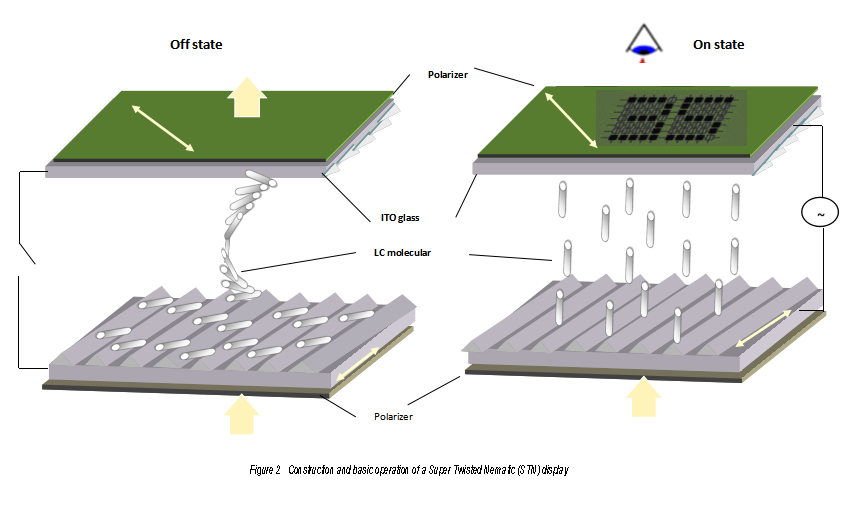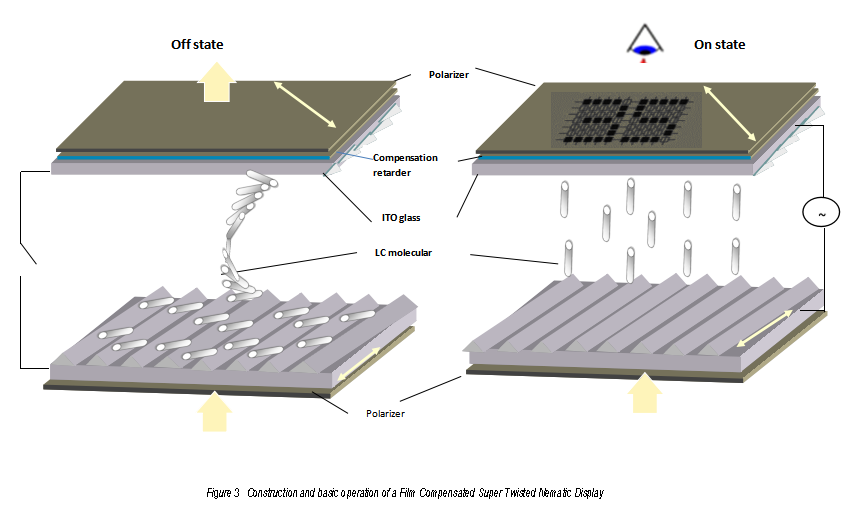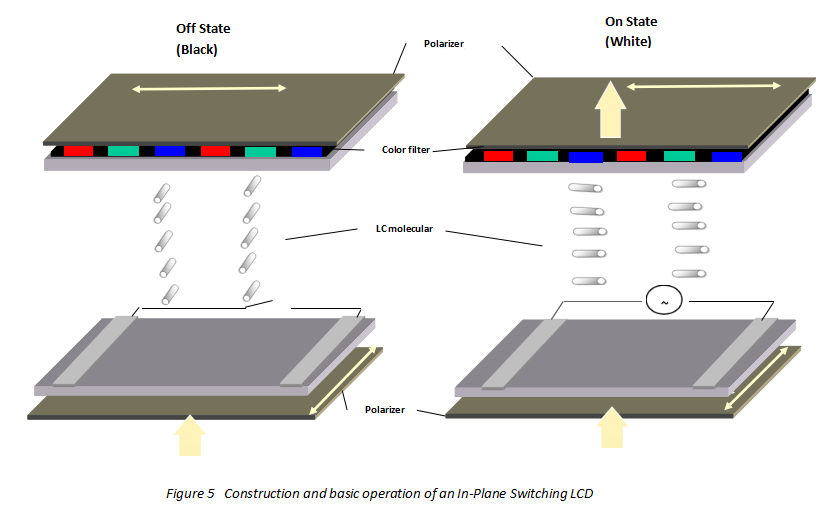Twisted Nematic Display- TN-LCD
A Twisted Nematic Display- TN-LCD has liquid crystal material sandwiched between two glass substrates coated with transparent indium-tin-oxide (ITO), polyimide alignment layers are coated on the ITO surface, then they are usually rubbed in one direction, as a result, the LC molecules orient parallel to the rubbing direction. The rubbing directions on two substrates are perpendicular to each other, a 90 degrees twist of director from one substrate to the other is formed inside the cell.
Two polarizers are laminated on the outside of ITO glasses in a way that its polarization parallel to the rubbing direction of the same glass substrate and are perpendicular or crossed each other.
In the off state, the 90° twist results in a 90° rotation of the light polarization after passing through the LC cell, the light emerges after the cell is linearly polarized, and therefore passes through the second polarizer which is perpendicular to the first polarizer. This is called the normally white (NW) mode, since light is transmitted without voltage is applied.
When an electric field is applied, the nematic liquid crystal molecules align to the electric field and lose the helix pattern and become untwisted. Light is no longer twisted through 90° and is blocked by the second polarizer, the display appears bright/off-state.
TN-LCD Pros:
- Low drive voltage 3-5 volt
- Low power consumption
- Fast response
- Low cost
TN-LCD Cons
- Contrast is very viewing angle dependent
- Multiplexibility is limited to 1/8 duty
- Display segments only, uncapable of displaying graph

STN-LCD (Supertwist Nematic Display)
A nematic liquid crystal doped with a few percent of optically active material is filled in the cell to sustain a twist angle ranging from 180 to 270°, this extra rotation allows STN-LCDs have a sharp voltage-brightness response curve, therefore additionally widens the viewing angle and achieves a higher contrast.
The polarizers are oriented “off-axis and the Δnd of the layer and polarizer orientation are adjusted for an optimum combination of contrast ration and display brightness for a given multiplexing ratio. The linear polarized light passing through the STN layer becomes elliptically polarized with ellipticity and principal axis direction that are strongly wavelength dependent.
STN-LCD Pros:
- High degree of multiplexibility ( 1/16~ 1/240)
- Higher contrast ratio 20:1
- Low power consumption
- Low cost
STN-LCD Cons
- Contrast is viewing angle dependent
- Response time (>100ms) slower than TN-LCD
- Display background color at the OFF state is prominent tone of yellow-green or purplish-blue if the NB polarizer orientation
- Cost is higher than TN-LCD

FSTN-LCD- Film Compensated Super Twisted Nematic Display
FSTN-LCD is configured with a single or double layer of birefringent film laminated together with top or both polarizers to compensated a STN layer in its OFF state for the color tone added by the birefringence effect. This allows a black characters or graph on a white/gray background to be produced and provides for a higher contrast and wider viewing angle.
Many variables involved with FSTN-LCD, the Δnd product of the STN layer, the retardation of the film, orientation of the film and orientation of polarizers are variables as well
FSTN-LCD Pros:
- High degree of multiplexibility (1/16~ 1/240)
- Black and white image, no more yellow-green or blue tone
- Better viewing angle and contrast ratio
FSTN-LCD Cons
- Contrast is viewing angle dependent
- Response time (>100ms) slower than TN-LCD
- Cost is higher than STN-LCD

TFT-LCD -Thin Film Transistor Liquid Crystal Display
TFT is a type of TN display but with color image where a transistor embedded and arranged in a matrix on a glass substrate to control each of three sub-pixels (Red/Green/Blue, RGB), and another glass substrate with a color filter (RGB) and transparent counter electrodes.
In addition, polarizers are placed on the outer side of each glass substrate and a backlight source on the back side. A change in voltage applied to liquid crystals changes the transmittance of the panel including the two polarizing plates, and thus changes the quantity of light that passes from the backlight to the front surface of the display.
This principle allows the TFT LCD to produce full-color images. TFT-LCD uses thin-film-transistor to enhance multiplexibility and addressability and contrast. Large number of pixels are involved. Each sub-pixel of TFT-LCD is individually controlled by an isolated Thin-Film Transistor (TFT) that is patterned into the glass layer; it allows the electrical signal for each sub-pixel to avoid influencing adjacent elements
TFT-LCD Pros
- Fastest response time
- Super high refresh capability
- Comparatively low production cost compared with VA and IPS panels
- Better contrast and viewing angle than passive monochrome display
- Higher resolution
- Gray scale
TFT-LCD Cons
- Smaller viewing angle than IPS or VA display especially vertically as well as weaker color performance and typically the lower contrast ratio than IPS and VA display. Contrast and color tone shifts can be evident with even a slight movement off-centre,
- Low-quality color reproduction, not great for color critical work due to viewing angle primarily
- Quite poor black depth
- Native 8-bit display
- Require a high brightness backlight

IPS (In-Plane Switching) LCD
IPS display differs from TFT display not only in the structure of the liquid crystals, but also in the placement of the electrodes. Liquid crystal molecules in the cell of IPS display lying always in the same plane and being always parallel to the display ‘s plane. Two electrodes are in the same plane and aligned on a single glass substrate.
In the off state, LC director has a uniform orientation throughout the cell, and no change is on the light polarization, the exit polarizer is placed perpendicular to the front polarizer and hence blocks the light.
When a voltage is applied to the substrate surface, the LC molecules with a positive dielectric anisotropy align themselves with their long axis parallel and make a 90-degrees turn to an applied electrical field direction, a phase change is placed on the light, hence light transmits after the exit polarizer. Since the LC director always remains in the plane of substrate, the viewing cone is very symmetric and wide. The improved angle and color technology features provide an overall better experience for the user.
IPS-LCDs features two transistors for each pixel, whereas TFT-LCDs use just one. This requires a more powerful backlight, which delivers more accurate colors and lets the screen be viewed from a wider angle
IPS Pros:
- Best color image, contrast and color accuracy and consistency under different viewing angles
- Widest viewing angle 178/178
- Mid-tier response time, faster response time than VA panel but slower than TFT panel
- Freedom from off-center color or contrast shift seen from VA displays
- Unlike TN LCDs, IPS panels do not lighten or show tailing when touched. This is important is particularly advantageous for touch-screen displays like those on smartphones and touch-screen laptops.
- 10-bit panels available
IPS Cons
- Longer response time than TFT display
- More expensive to produce than TN panels
- ~15% More power consumption than a TFT-LCD
- Distracting white glow from an angle when viewing dark content (IPS glow)

VA Display – Vertical Alignment Display
The Liquid Crystals is aligned vertically or perpendicular to the substrate at the off state, thus produces a black image. When a voltage is applied, the molecules tilt to a horizontal position, the polarized light passes through and produces a white image at On-state
VA-LCD Pros
- Best contrast ratio among all display panel types
- Best black depth
- Wide view angle
- 8-bit color depth
VA-LCD Cons
- Response time slower than TFT
- Off-center contrast shifts inherent to all MVA panel generation. Not ideal for color critical work.
- Viewing angle not as wide as IPS.
- No 10-bit panels available



